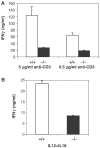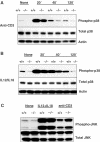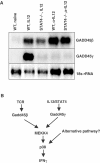GADD45beta/GADD45gamma and MEKK4 comprise a genetic pathway mediating STAT4-independent IFNgamma production in T cells
- PMID: 15044949
- PMCID: PMC391077
- DOI: 10.1038/sj.emboj.7600173
GADD45beta/GADD45gamma and MEKK4 comprise a genetic pathway mediating STAT4-independent IFNgamma production in T cells
Abstract
The stress-inducible molecules GADD45beta and GADD45gamma have been implicated in regulating IFNgamma production in CD4 T cells. However, how GADD45 proteins function has been controversial. MEKK4 is a MAP kinase kinase kinase that interacts with GADD45 in vitro. Here we generated MEKK4-deficient mice to define the function and regulation of this pathway. CD4 T cells from MEKK4-/- mice have reduced p38 activity and defective IFNgamma synthesis. Expression of GADD45beta or GADD45gamma promotes IFNgamma production in MEKK4+/+ T cells, but not in MEKK4-/- cells or in cells treated with a p38 inhibitor. Thus, MEKK4 mediates the action of GADD45beta and GADD45gamma on p38 activation and IFNgamma production. During Th1 differentiation, the GADD45beta/GADD45gamma/MEKK4 pathway appears to integrate upstream signals transduced by both T cell receptor and IL12/STAT4, leading to augmented IFNgamma production in a process independent of STAT4.
Figures







References
-
- Afkarian M, Sedy JR, Yang J, Jacobson NG, Cereb N, Yang SY, Murphy TL, Murphy KM (2002) T-bet is a STAT1-induced regulator of IL-12R expression in naive CD4+ T cells. Nat Immunol 3: 549–557 - PubMed
-
- Avni O, Lee D, Macian F, Szabo SJ, Glimcher LH, Rao A (2002) T(H) cell differentiation is accompanied by dynamic changes in histone acetylation of cytokine genes. Nat Immunol 3: 643–651 - PubMed
-
- Avni O, Rao A (2000) T cell differentiation: a mechanistic view. Curr Opin Immunol 12: 654–659 - PubMed
-
- Camps M, Nichols A, Arkinstall S (2000) Dual specificity phosphatases: a gene family for control of MAP kinase function. FASEB J 14: 6–16 - PubMed
Publication types
MeSH terms
Substances
Grants and funding
LinkOut - more resources
Full Text Sources
Molecular Biology Databases
Research Materials
Miscellaneous

